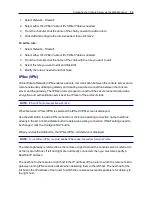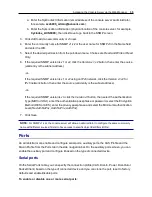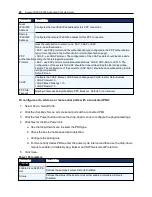
34
.....
Avocent® ACS 6000 Advanced Console Server
A Fully Qualified Domain Name should be indicated in the ID fields for both the Local (Left) host and
the Remote (Right) host where the IPSec negotiation takes place.
The following table describes the fields and options on the
IPSec(VPN) - Add
screen. The
information must match exactly on both ends for local and remote.
Field Name
Definition
Connection
Name
Any descriptive name you wish to use to identify this connection.
Authentication
Protocol
The authentication protocol used, either ESP (Encapsulating Security Payload) or AH
(Authentication Header).
Boot Action
The boot action configured for the host, either
Ignore
,
Add
or
Start
.
Authentication
Method
Authentication method used, either RSA Public Keys or Shared Secret.
Remote
(Right) Side -
and - Local
(Left) Side
Enter the required address or text for each of the four fields for both Remote Side and Local
Side: ID: This is the hostname that a local system and a remote system use for IPSec
negotiation and authentication. It can be a fully qualified domain name preceded by @. For
example,
[email protected] IP Address: The IP address of the host. NextHop: The router
through which the console server (on the left side) or the remote host (on the right side) sends
packets to the host on the other side. SubNet: The netmask of the subnetwork where the host
resides. Use CIDR notation. The IP number followed by a slash and the number of ‘one’ bits in
the binary notation of the netmask. For example, 192.168.0.0/24 indicates an IP address
where the first 24 bits are used as the network address. This is the same as 255.255.255.0.
RSA Key (If
RSA Key
is
selected)
For IPSec(VPN) authentication, you need to generate a public key for the console server and
find out the key used on the remote gateway. Copy and paste for copying the RSA key from
another source is supported.
Pre-Shared
Secret (If
Secret is
selected)
Pre-shared password between left and right users.
Field and Menu Options for Configuring IPSec(VPN)
SNMP Configuration
An administrator can configure SNMP, which is needed if notifications are to be sent to an SNMP
management application.
NOTE:
The Avocent ACS 6000 Enterprise MIB text file is available in the appliance at:
/usr/local/mibs/ACS6000-MIB.asn. The Avocent ACS 6000 Enterprise TRAP MIB text file is available in
the appliance at: /usr/local/mibs/ACS6000-TRAP-MIB.asn. Both files are also available at
www.avocent.com.
To configure SNMP:
1. Click
Network - SNMP
.
2. Click the
System
button.
Summary of Contents for Avocent ACS 6000
Page 1: ...Avocent ACS 6000 Advanced Console Server Installer User Guide ...
Page 6: ......
Page 12: ...Introduction 6 ...
Page 22: ...Installation 16 ...
















































